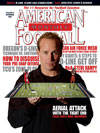AMERICAN FOOTBALL MONTHLY THE #1 RESOURCE FOR FOOTBALL COACHES
Article CategoriesAFM Magazine
|
The Strength Report: Developing the Explosive Athlete - Running Backsby: Scott Swanson, MSCCStrength & Conditioning Coach, U.S. Military Academy © More from this issue The cadets at West Point are highly motivated. They are at the United States Military Academy because the objective and goal is that they all will be great officers and that is the number one priority; that is, to do everything possible so they will be great officers. The entire training mission at the USMA is to get the cadets to be leaders. At Army, my program is built around a year-long periodized program. We utilize the non-linear periodization cycle and we approach it with the four quarters of the year: 1. The off season program; 2. Spring practice; 3. Summer program; and 4. The in season program. With the cadets we train, we normally have them for three hours, usually 3pm-6pm during the week. Itís critical that they invest time in the weight room and not just spend time here. The Army way is intensity. Everything we do is ....The full article can only be seen by subscribers. Subscribe today!
|
|
|||||||
| HOME |
MAGAZINE |
SUBSCRIBE | ONLINE COLUMNISTS | COACHING VIDEOS |
Copyright 2025, AmericanFootballMonthly.com
All Rights Reserved





